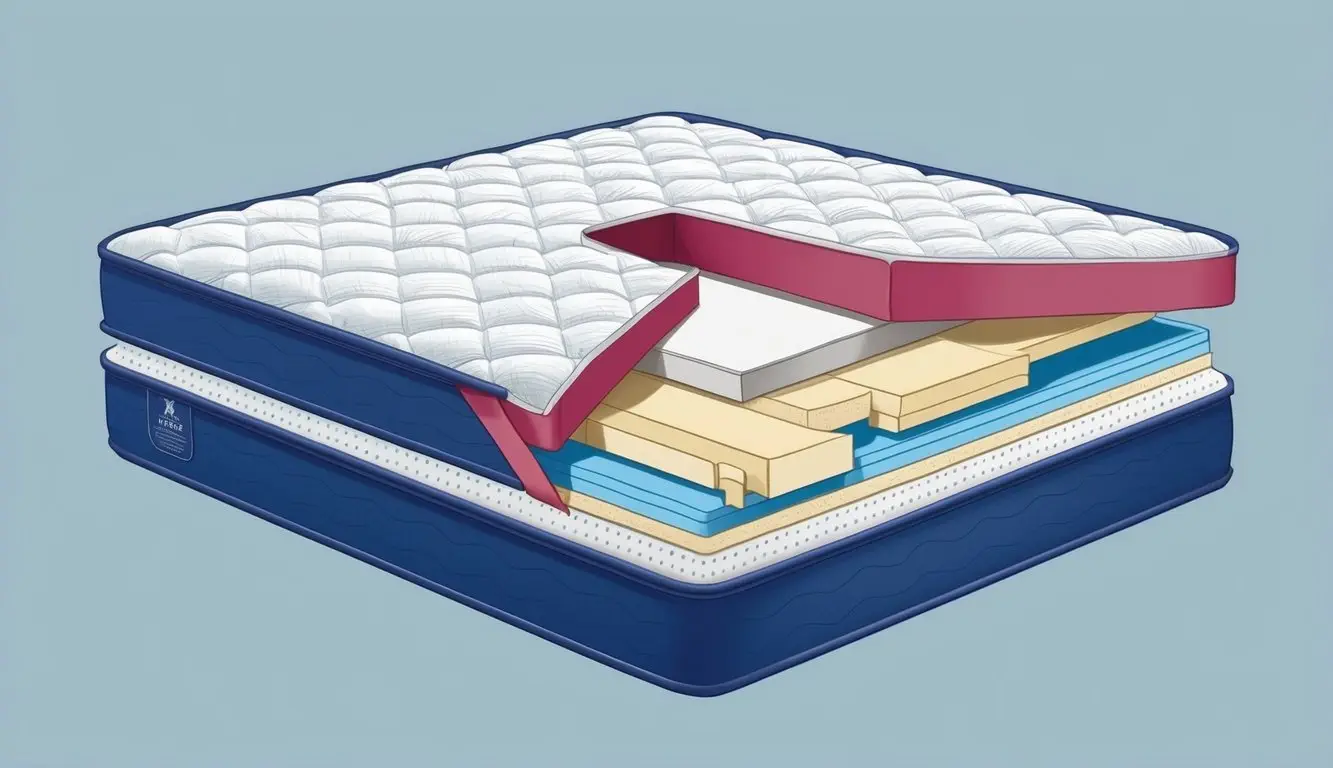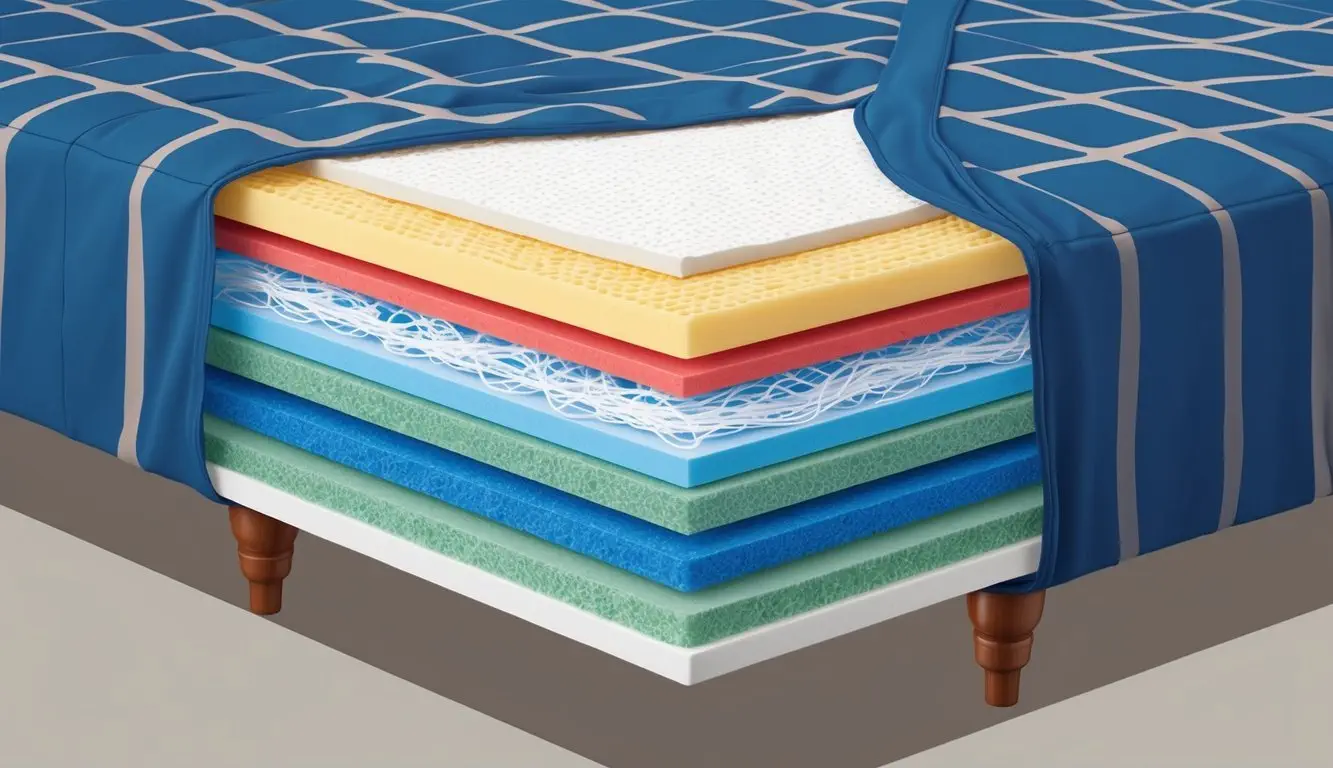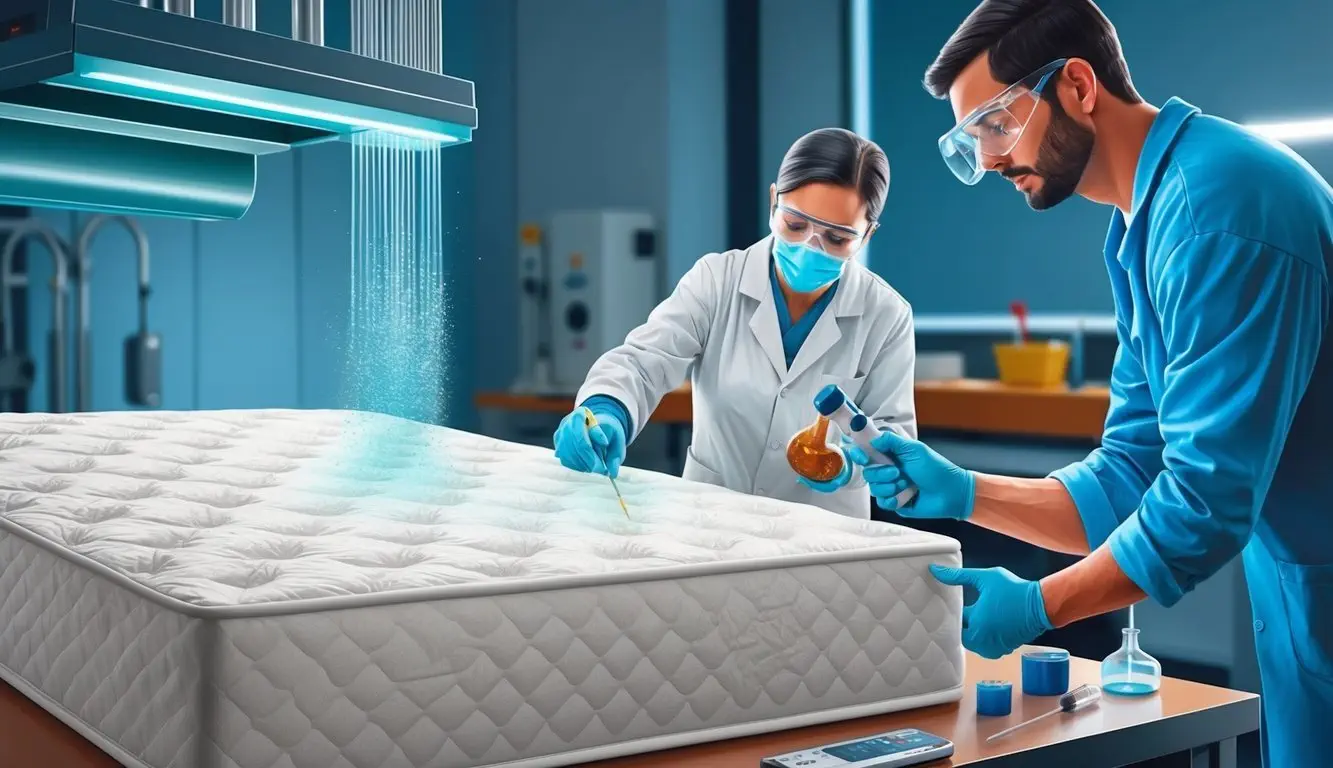When shopping for a mattress, safety is a top concern for many people. This is especially true when it comes to potentially harmful materials like fiberglass, which some mattress brands use as a fire retardant.

DreamCloud mattresses do not contain fiberglass. The company uses alternative fire barrier materials that meet safety regulations without including fiberglass in their design.
DreamCloud opts for natural and safer fire-resistant materials instead. This makes their mattresses a good option for consumers who are concerned about potential health issues related to fiberglass exposure from bedding products.
Understanding Fiberglass in Mattresses

Fiberglass is a common material found in many mattresses, primarily serving as a fire barrier. This synthetic material raises important concerns about safety and potential health impacts when used in sleep products.
What Is Fiberglass?
Fiberglass consists of extremely fine glass fibers woven together to create a fabric-like material. These thin strands are made by forcing molten glass through small holes, then cooling it quickly to form flexible fibers.
The resulting material is lightweight yet strong. It’s also relatively inexpensive to manufacture.
Fiberglass is valued for its durability and heat resistance. These properties make it useful in various industries, from construction to automotive manufacturing.
In mattresses, fiberglass typically appears as a thin layer between the cover and inner materials. It’s often not visible to consumers until the mattress cover is removed or damaged.
Common Uses of Fiberglass in Mattresses
Fiberglass serves primarily as a fire retardant in mattresses. Federal regulations require all mattresses sold in the US to meet specific flammability standards.
Manufacturers choose fiberglass because it:
- Effectively slows or prevents fire spread
- Costs less than other fire barrier options
- Meets legal safety requirements
- Doesn’t require chemical treatments
The fiberglass layer typically sits beneath the mattress cover. When a fire occurs, this layer melts rather than burns, creating a barrier that helps protect the more flammable materials inside.
Some budget mattress brands rely heavily on fiberglass. Higher-end mattresses often use alternative fire barriers like wool, silica, or plant-based materials.
Health Risks Linked to Fiberglass
Fiberglass particles can cause significant health problems if released into your home. This typically happens when mattress covers are removed or become damaged.
Respiratory issues are common when fiberglass becomes airborne. These microscopic shards can be inhaled, causing:
- Coughing and wheezing
- Throat and lung irritation
- Worsened asthma symptoms
Skin contact with fiberglass results in irritation similar to fiberglass insulation exposure. This includes itching, redness, and small, painful rashes.
Fiberglass contamination in homes can be extremely difficult to clean. The tiny particles spread easily through air systems and can settle on surfaces throughout your living space, affecting indoor air quality.
Children and pets face higher risks due to their smaller size and developing respiratory systems.
Does Dreamcloud Mattress Have Fiberglass

DreamCloud mattresses combine premium materials and thoughtful design elements to create a luxurious sleep experience. They offer several distinct features that set them apart from other mattress brands on the market.
Construction and Materials
DreamCloud mattresses feature a hybrid design that combines multiple layers of high-quality materials. The mattress includes gel-infused memory foam that helps regulate temperature during sleep by drawing heat away from the body.
Instead of fiberglass, DreamCloud uses alternative fire barriers made from non-toxic materials that meet federal flammability standards. This is an important consideration for health-conscious consumers.
The top layer often includes a soft cashmere blend cover that provides a plush feel against the skin. This premium material adds to the luxury experience of the mattress.
Below the comfort layers, individually wrapped coils provide targeted support and minimize motion transfer. These coils are arranged to enhance edge support and maintain the structural integrity of the mattress.
Comfort and Support Layers
DreamCloud mattresses typically contain multiple foam layers designed for optimal comfort. The top comfort layers include pressure-relieving memory foam that contours to the body’s shape.
Some models incorporate latex foam for added responsiveness and bounce. This material provides a nice balance between the hug of memory foam and the firmness needed for proper spinal alignment.
The transition layers help distribute body weight evenly across the mattress surface. This prevents pressure points from forming around sensitive areas like shoulders and hips.
The support core consists of individually wrapped coils that respond independently to movement. This design helps isolate motion and provides customized support for different body types.
Certification and Safety
DreamCloud mattresses carry CertiPUR-US certification, which verifies that the foams used are free from harmful chemicals. This includes verification that they contain no ozone depleters, formaldehyde, or heavy metals.
The fire barrier used in DreamCloud mattresses complies with federal safety regulations without using fiberglass. Instead, they utilize alternative fire retardants that are safer for households.
All materials undergo testing to ensure they meet strict quality and safety standards. This includes durability testing to confirm the mattress will maintain its structural integrity over time.
DreamCloud publishes their material specifications and safety information on their website for transparent consumer access. This openness about materials reflects their commitment to customer safety and satisfaction.
Safety and Health Considerations

When evaluating mattresses, safety and health factors should be top priorities. DreamCloud takes several measures to ensure their mattresses meet strict quality standards while minimizing potential health risks to users.
Fiberglass and Flame Retardancy
DreamCloud mattresses do not contain fiberglass as a flame retardant. Instead, they use alternative fire barriers made from natural or synthetic materials that meet federal fire safety standards. These alternatives include silica-based barriers or wool, which provide effective protection without the health risks associated with fiberglass.
Many lower-cost mattresses use fiberglass because it’s inexpensive and effective at slowing fires. However, when fiberglass escapes from mattresses, it can cause skin irritation, respiratory issues, and extensive home contamination.
DreamCloud’s approach prioritizes safety without compromising on fire protection. Their fire barriers are fully enclosed within the mattress, preventing any chance of exposure during normal use.
Certipur-US Certified Components
DreamCloud uses CertiPUR-US certified foams in their mattresses. This certification ensures several important health and safety standards:
- Low VOC emissions (less than 0.5 parts per million)
- No ozone depleters
- No mercury, lead, or heavy metals
- No formaldehyde
- No prohibited phthalates
These standards mean the foams used in DreamCloud mattresses have been tested by independent laboratories. The certification helps reduce exposure to harmful chemicals that can cause headaches, respiratory irritation, and other health issues.
CertiPUR-US certification is particularly important for memory foam components, which historically could contain concerning chemicals.
Hypoallergenic and Non-Toxic Options
DreamCloud offers hypoallergenic features in their mattress designs. The mattress covers are typically made from breathable fabrics that resist dust mites and other common allergens.
The company uses materials designed to be non-toxic and safe for sensitive individuals. Their mattresses feature:
- Breathable covers that resist dust mite accumulation
- Low-VOC materials that reduce chemical exposure
- Natural or synthetic flame retardants instead of fiberglass
For those with chemical sensitivities, DreamCloud’s commitment to CertiPUR-US certification helps ensure lower chemical off-gassing compared to non-certified mattresses.
Proper ventilation of any new mattress for 24-48 hours is still recommended to allow initial odors to dissipate, though these are typically minimal with DreamCloud products.
DreamCloud Mattress Fiberglass Content

DreamCloud mattresses are designed with specific safety and comfort considerations in mind. The materials used in these mattresses are an important factor for consumers concerned about potential health hazards.
Fiberglass-Free Mattress Claims
DreamCloud openly states that their mattresses do not contain fiberglass. This is a significant selling point for health-conscious consumers. The company uses alternative fire retardants that meet safety regulations without incorporating fiberglass.
Instead of fiberglass, DreamCloud mattresses use natural or synthetic fire barriers. These materials include:
- Wool (natural fire resistant properties)
- Silica-based barriers
- Thistle-based materials
- Proprietary fire-resistant fabrics
These alternatives provide the necessary fire protection required by law. Many customers specifically search for fiberglass-free mattresses due to health concerns related to fiberglass particles.
Transparency in Material Usage
DreamCloud provides detailed information about their mattress materials on their website and product labels. This transparency helps customers make informed decisions about their purchases.
The company clearly lists the components used in each layer of their mattresses. Their mattress covers are typically made from materials like:
- Cashmere blend fabrics
- Organic cotton
- Hypoallergenic textiles
DreamCloud also offers documentation about their safety certifications. These certifications often include CertiPUR-US® for foams, which verifies the absence of harmful chemicals.
Customers can request full material lists directly from customer service. This open approach to material disclosure builds trust with consumers concerned about what’s inside their mattress.
Protecting Your Mattress and Health

Proper protection measures can significantly reduce exposure risks and maintain sleep quality when dealing with mattresses. Taking proactive steps helps safeguard both your investment and respiratory health.
Choosing the Right Mattress Protector
A high-quality mattress protector creates an essential barrier between you and potential irritants in your mattress. Look for protectors labeled as “waterproof” or “allergen-proof” that completely encase the mattress with a zipper closure.
The best protectors use tightly woven fabrics with pore sizes smaller than 10 microns. This construction blocks microscopic particles like fiberglass while still allowing air circulation.
Materials matter significantly. Opt for protectors made of polyurethane, vinyl, or specially treated cotton. These materials create effective barriers without compromising comfort.
Before purchasing, verify that the protector is specifically designed to block glass fibers. Many quality brands advertise this feature clearly on packaging or product descriptions.
Maintaining Indoor Air Quality
Regular vacuuming around the bed area helps capture any escaped particles. Use a vacuum with a HEPA filter for maximum effectiveness in trapping microscopic irritants.
Air purifiers with HEPA filtration can remove airborne fiberglass particles. Placing one near the bed creates an additional layer of protection for healthy sleep.
Washing bedding weekly in hot water helps eliminate accumulated dust and potential fibers. Use the highest temperature setting your linens can tolerate.
Monitor humidity levels in the bedroom. Maintaining 40-50% humidity prevents excessive dryness that can make fiberglass particles more airborne and irritating to respiratory passages.
If you notice any tears in your mattress cover, address them immediately. Apply duct tape to prevent fiber release until you can replace the mattress or cover completely.
Customer Experience with DreamCloud

Actual user experiences provide valuable insights about DreamCloud mattresses and their materials. Customers have shared both positive feedback and concerns regarding comfort, support, and potential allergens.
Reviews and Feedback on Comfort
Most DreamCloud customers report high satisfaction with their mattress comfort. The hybrid design combining memory foam and coils receives praise for balancing softness and support.
A significant number of reviewers mention improved sleep quality after switching to DreamCloud. Many highlight reduced back pain and better spinal alignment.
Some users specifically note the absence of allergic reactions, which can be relevant for those concerned about fiberglass. One reviewer stated, “I’ve had sensitivity to other mattresses, but experienced no issues with DreamCloud.”
The mattress earns high marks for temperature regulation. The gel-infused memory foam helps prevent overheating, a common complaint with other foam mattresses.
Warranty and Customer Support Services
DreamCloud offers a lifetime warranty, which stands out compared to the industry standard 10-year coverage. This warranty covers manufacturing defects and premature sagging greater than 1.5 inches.
Their 365-night sleep trial gives customers a full year to test the mattress. This generous policy exceeds most competitors’ trial periods.
Customer support receives mixed reviews. Many customers praise the responsive service team when addressing concerns or processing returns.
Some users report delays when filing warranty claims or seeking information about mattress materials. Response times can vary depending on contact method, with chat support typically being fastest.
DreamCloud’s white glove delivery service earns positive feedback for convenient setup and old mattress removal, though this service comes at an additional cost.
Alternatives to Fiberglass in Mattresses

Many mattress manufacturers have moved away from fiberglass, using safer materials that still meet fire safety regulations while protecting consumers’ health.
Natural and Synthetic Options
Natural Latex Foam serves as an excellent fiberglass alternative. It’s naturally flame-resistant without added chemicals. This material comes from rubber trees and provides durability and comfort.
Natural Wool functions as an effective flame barrier. It can self-extinguish when exposed to fire because of its high moisture and protein content. Wool is renewable, biodegradable, and doesn’t release harmful chemicals.
Silica-Based Flame Retardants offer another option. Unlike fiberglass, these materials don’t easily become airborne or cause skin irritation.
Plant-Based Fibers like cotton and thistle have gained popularity. These materials provide natural fire resistance without the risks associated with fiberglass.
Kevlar and other synthetic options also work well. These engineered materials can meet safety standards without shedding tiny particles into the home environment.
Brands Offering Fiberglass-Free Mattresses
Several manufacturers prioritize fiberglass-free designs. Nectar uses a silica-based fire sock instead of fiberglass in their newer models. Their website now clearly states which products contain no fiberglass.
Sleep Innovations and Lucid have shifted toward safer alternatives in many of their premium lines. Both brands now offer mattresses with natural barriers like wool.
Olee Sleep produces several models using alternative fire barriers. Their product descriptions typically highlight the absence of fiberglass.
Budget-friendly options exist too. While Zinus and Linenspa historically used fiberglass, both now offer select models without it. Always check product descriptions or contact customer service directly to confirm.
Vibe mattresses have varied compositions. Some higher-end models use alternatives like silica-based barriers instead of fiberglass.
Frequently Asked Questions

Consumers often have specific questions about mattress construction, materials, and safety concerns. These common questions address the key aspects of DreamCloud mattresses that shoppers want to know before making a purchase.
What materials are used in the construction of DreamCloud mattresses?
DreamCloud mattresses use a combination of materials in their construction. They typically feature multiple layers including gel memory foam, support foam, and individually wrapped coils.
The cover is made of cashmere blend fabric, which provides softness and breathability. The comfort layers contain gel-infused memory foam for cooling properties.
DreamCloud does not list fiberglass as a component in their mattresses. Instead, they use alternative fire retardant materials that comply with federal safety regulations.
Are there any safety concerns associated with DreamCloud mattresses?
DreamCloud mattresses are designed with safety in mind and comply with all federal flammability standards. They do not use fiberglass as a fire retardant, reducing concerns about fiber release.
The company states they use non-toxic materials in their construction. Their mattresses are CertiPUR-US certified, meaning the foams are made without harmful chemicals like formaldehyde, heavy metals, and certain flame retardants.
Consumers with specific allergies or sensitivities should review the full materials list available on the company website.
What should I look for to determine if a mattress contains fiberglass?
Check the law tag or mattress label, which legally must list all materials. Look for terms like “glass fiber,” “glass wool,” or “fiberglass” in the materials list.
Contact the manufacturer directly and ask specifically if fiberglass is used as a fire barrier. Reputable companies will provide clear information about their fire retardant methods.
Be cautious of very low-priced mattresses, as fiberglass is often used as an inexpensive fire barrier solution. Mattresses advertised as using natural fire barriers or alternative solutions typically don’t contain fiberglass.
There have been few reported complaints specifically about fiberglass in DreamCloud mattresses. Most customer reviews focus on comfort, durability, and customer service aspects.
Online review platforms and consumer protection websites don’t show significant patterns of material-related complaints for DreamCloud products. The brand maintains relatively positive ratings for material quality.
It’s worth noting that DreamCloud openly discusses their materials and fire barrier solutions without mentioning fiberglass use.
How do DreamCloud mattresses compare to other brands in terms of material safety?
DreamCloud ranks favorably compared to budget brands that often use fiberglass as a fire retardant. Their use of alternative fire barriers places them in line with other mid to premium mattress companies.
Like other certified mattresses, DreamCloud products carry the CertiPUR-US certification for their foams. This certification has become an industry standard for safety in foam materials.
DreamCloud’s transparency about materials and construction details provides consumers with information needed to make informed safety comparisons.
Can you provide a comparison of the construction materials used in DreamCloud versus other popular mattress brands?
DreamCloud uses hybrid construction with coils and multiple foam layers, similar to brands like Saatva and Helix. Unlike some budget brands such as Zinus, DreamCloud doesn’t use fiberglass fire barriers.
DreamCloud’s cashmere blend cover differs from the cotton or polyester covers found on many competitors. Their gel memory foam layers are comparable to those used by Nectar and Puffy.
For fire protection, DreamCloud uses alternative methods similar to those found in Casper and Purple mattresses, while brands like Lucid and some Amazon Basics mattresses often utilize fiberglass barriers.